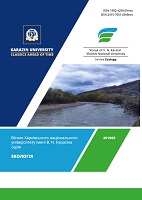Роль органів місцевого самоврядування в адміністративно-правовому регулюванні підтримання екологічної безпеки
Анотація
Здійснено порівняльний аналіз основних положень Стратегій державної екологічної політики до 2020 року та до 2030 року. З’ясовано, що до 2020 року відповідальність за доступність та достовірність екологічної інформації покладалась на органи виконавчої влади, а не органи місцевого самоврядування. Зазначено, що до 2020 року показником ефективності Стратегії було встановлено кількість прийнятих місцевих планів дій з охорони довкілля, серед якісних показників передбачено проведення стратегічної екологічної оцінки, однак, профільний закон було прийнято через 7 років після Стратегії, а перші оцінки проведено лише в 2019 році. З’ясовано, що Стратегія до 2030 року потребує коректив або в частині перерахунку запланованих цілей щодо досягнення показника індексу екологічної ефективності (ЕРІ) .
Направлення більшої частини доходу від справляння екологічного податку до загального фонду державного бюджету створило ризики їх нецільового використання, що не дає змоги місцевому самоврядуванню в повній мірі здійснювати природоохоронні заходи відповідно до потреб міст та областей. Серед основних пропозицій по вдосконаленню вказаної ситуації є підвищення розмірів екологічного податку, зміна розподілу надходжень від екологічного податку з сторону збільшення доходів до місцевих бюджетів, розробка механізму економічного стимулювання підприємств, які здійснюють заходи з підтримання екологічної безпеки.
##submission.downloads##
Опубліковано
Номер
Розділ
Ліцензія
Авторське право (c) 2022 Беспалова О. В., Беспалов С. І., Приданов Я. О.

Ця робота ліцензується відповідно до Creative Commons Attribution 4.0 International License.
Автори, які публікуються у цьому журналі, погоджуються з наступними умовами:
- Автори залишають за собою право на авторство своєї роботи та передають журналу право першої публікації цієї роботи на умовах ліцензії Creative Commons Attribution License 4.0 International (CC BY 4.0), котра дозволяє іншим особам вільно розповсюджувати опубліковану роботу з обов'язковим посиланням на авторів оригінальної роботи та першу публікацію роботи у цьому журналі.
- Автори мають право укладати самостійні додаткові угоди щодо неексклюзивного розповсюдження роботи у тому вигляді, в якому вона була опублікована цим журналом (наприклад, розміщувати роботу в електронному сховищі установи або публікувати у складі монографії), за умови збереження посилання на першу публікацію роботи у цьому журналі.
- Політика журналу дозволяє і заохочує розміщення авторами в мережі Інтернет (наприклад, у сховищах установ або на особистих веб-сайтах) рукопису роботи, як до подання цього рукопису до редакції, так і під час його редакційного опрацювання, оскільки це сприяє виникненню продуктивної наукової дискусії та позитивно позначається на оперативності та динаміці цитування опублікованої роботи (див. The Effect of Open Access).

